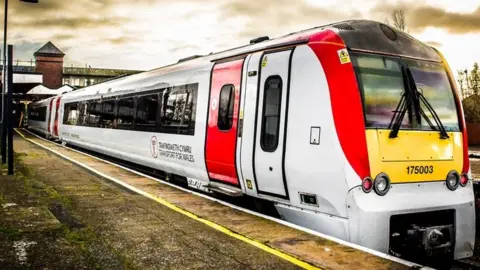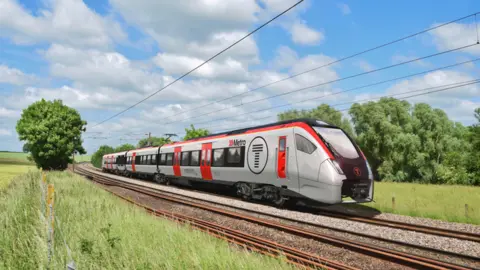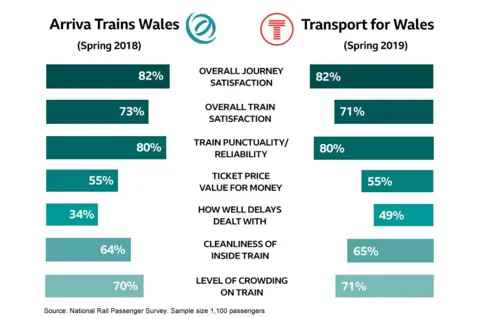Trains: When will overcrowding on Transport for Wales services end?
 TfW
TfWA year after Transport for Wales took over the all-Wales rail franchise, passengers have been left frustrated at the pace of change, with overcrowding among the top complaints.
TfW bosses said five additional trains have provided extra capacity since May with more newer trains expected in December 2019.
However, they have also admitted improvements have been slower than they would have liked.
A spokesman said: "Some of the additional trains we were planning to introduce into service this year have been delayed.
"With a shortage of available diesel trains throughout Britain, it has proven challenging to source extra trains for our fleet, but we're pleased to have secured a number of trains on top of our original commitment."
Why is there a shortage of diesel trains across Britain?
Stuart Cole, professor of transport at the University of South Wales, said: "It's not just TfW who're trying to lease trains. Passenger numbers on the valley lines are increasing 7% year-on-year and the situation is similar all over the country, so every other franchise is trying to get their hands on the same trains.
"Then there's the question of the sort of trains. Most of Wales' rolling stock are 40-year-old Class 150s and 158s.
"It's not just a case of bolting any old units together, you have to source carriages with compatible couplings and electrical systems, which is increasingly difficult for those classes."
What else has been on TfW's plate in its first year?
TfW's takeover got off to the worst possible start last October, when Storm Callum damaged a third of their 127 trains.
It also made it harder to lease rolling stock as companies across the UK were all trying to get hold of replacements for storm-damaged trains.
In addition, much of TfW's ageing fleet has been taken out of service over the past year in order to be adapted to meet new regulations to make trains accessible for people with disabilities, due to come into effect in January 2020.
 TfW
TfWBut Welsh Government Economy Minister Ken Skates said TfW would not be able to meet the deadline without significantly cutting the number of trains operating.
He has asked the UK government for the organisation to be allowed to run some trains that do not comply with the new access rules "for a very short time".
When will we see the increased capacity?
On top of the 6,500 additional commuter spaces per week which will be created by December, TfW said "significant increases in frequency" will follow after the arrival of the first new trains in 2022.
By 2023, 95% of journeys on Welsh railways will be made on new trains.
Prof Cole believes TfW is on the right track, but had things been different, it might have been able to reach this milestone before 2023.
"I, along with plenty of other experts, told the UK and Welsh governments as long ago as 2013, that if TfW was to hit the ground running they had to start planning the infrastructure and ordering the rolling stock back then.

"Unfortunately wrangling over electrification and responsibility for TfW's routes through England meant that the Department for Transport in Westminster didn't hand over authority for the Welsh Government to get to work on this until a week before TfW's takeover.
"TfW therefore came at it from a standing start. Orders for new trains take years to fulfil, and plugging the gaps in the meantime with leased rolling stock isn't straightforward."
The Department for Transport has been asked to comment.
It is not just about extra carriages
Prof Cole said as TfW's plans come to fruition over the next five years, the number of carriages on a train will not be the main determining factor in tackling overcrowding.
He added: "The new commuter trains will have a layout more similar to a tube train. There will be fewer seats, but with wider aisles and grab rails so more people can stand safely for short journeys, in the same amount of space.
"Also, the improvements being made to signalling and track infrastructure will allow for much more frequent services."
He added increased frequency would reduce the need for longer trains, and help spread the flow of commuters throughout the rush hours.

This story was inspired by a question sent to us asking: "When will overcrowding on the trains end?"
What questions do you have about Wales, or its people and places?
Is there anything you've always wanted to know?
Use this form to send us your questions:
If you are reading this page on the BBC News app, you will need to visit the mobile version of the BBC website to submit your question on this topic.
We may get in touch if we decide to follow up on your suggestion.
